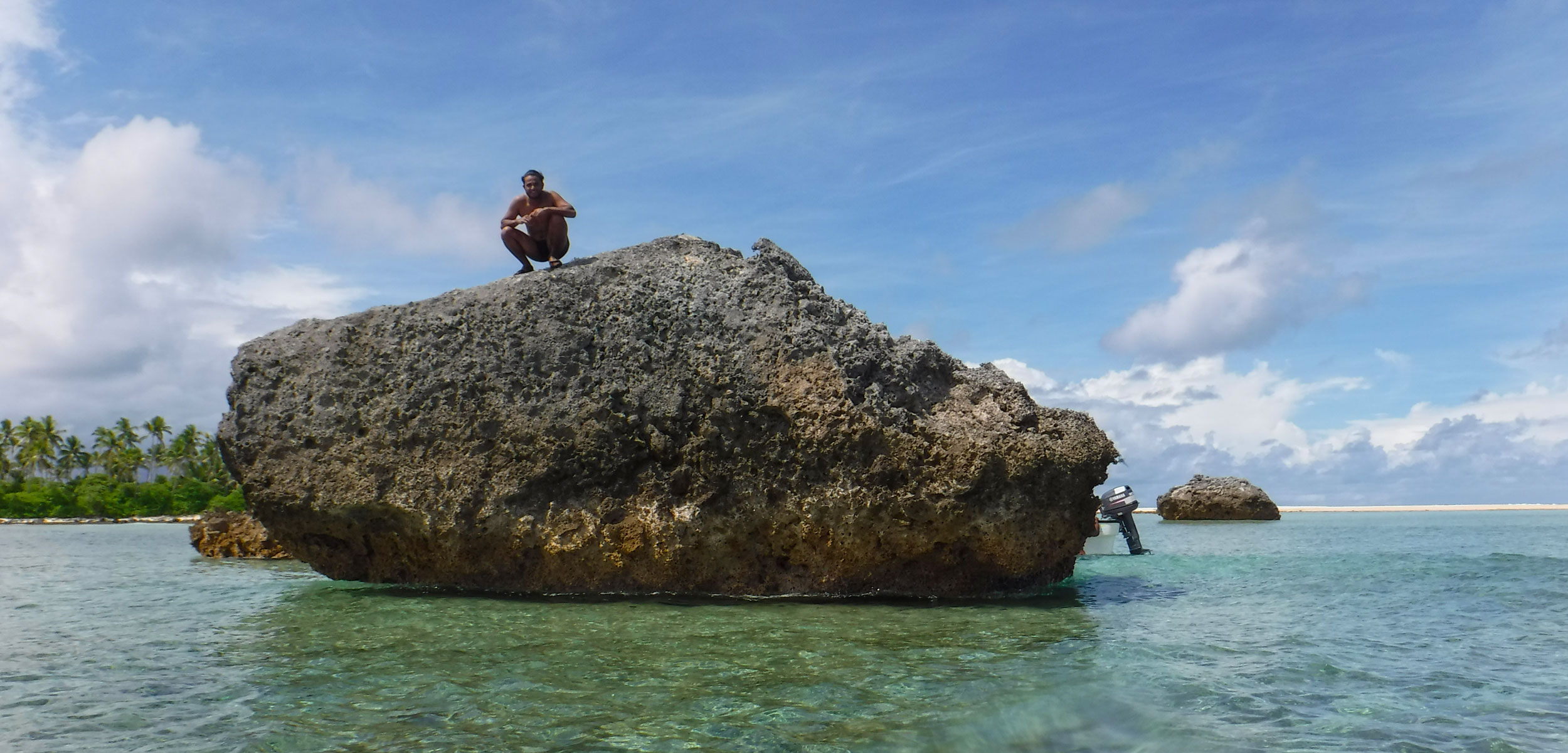Rounding Out the Story of Three Legendary Boulders
A scientific analysis has added new details to the origin story of Makin Island’s distinctively out-of-place rocks.
Article body copy
The first time James Terry heard the legend of Makin Island’s three boulders was in 2012. Romano Reo, a retired chief surveyor from the Kiribati Lands and Survey Department, emailed him and relayed the story of a fabled king who once lived on an island that is now part of the Republic of Kiribati in the central Pacific Ocean. In the story, people on the nearby Makin Island brought the king a gift of fruit. But the fruit was rotten, and the king, enraged by the affront, sent three giant waves to punish the Makin Islanders. Each wave carried a huge rock toward the shore. As the deluge crashed down, the terrified islanders begged for forgiveness. The king relented, stopping the third wave just in time.
The story grabbed Terry because, as a geoscientist at Zayed University in the United Arab Emirates, he had a thing about offshore boulders. He wondered if the story was, in fact, more than a story. It was possible that the tale about the angry king, passed down by the island’s Indigenous Micronesians, might be a geomyth—a legend that encodes true information about an area’s geological past.
And so, in June 2018, Terry and fellow researchers went to Makin Island to find out. They introduced themselves to the locals, making a traditional offering of tobacco to their ancestors. With their guidance, the researchers were led to Makin’s southern shores. There, standing proudly and almost entirely out of the water during low tide, were two massive rocks.
“They’re just sitting all alone, these isolated, huge boulders,” says Terry. Each of the rocks has a name. Arranged in a line, roughly east to west, are Tokia, a boulder 22 meters in circumference, and Rebua, slightly smaller at 18.5 meters. The third stone, Kamatoa, is the largest. Roughly 39 meters in circumference—broader than a school bus is long—Kamatoa is always underwater. It is the king’s mercy.
While on the trip, they unexpectedly met Tobeia Kabobouea, a man in his 60s who holds the position of the Wiin te Maneaba, or traditional storyteller. The man is a “living archive,” as Terry and his colleagues write in a recent paper. Noticing the scientists’ interest in the stones, Kabobouea offered to recite a story.
He proceeded to narrate a different tale from the one Terry had heard years earlier by email. The Wiin te Maneaba told the story of a Makin Island man who was cheated by his community. His neighbors on a nearby island had an ability to summon and hunt dolphins, but gave the Makin Island man only the internal organs—never the tastier meat. Out of anger, the man called three waves, each carrying a huge stone, and sent them hurtling toward the villagers. Eventually, he felt remorse and halted the final and most destructive wave.
That’s two distinct—yet strikingly similar—accounts of gigantic waves bearing Tokia, Rebua, and Kamatoa to their present resting places.
Terry and his colleagues then turned to the three boulders themselves.
Each boulder is made of coral. Because corals extract uranium from seawater—and because that uranium decays and turns into thorium when the coral dies—the ratio of uranium to thorium in dead corals can indicate when they died. “It works like an atomic clock,” says Terry. The analysis yielded a range of possible dates, with the most likely being 1576.
Based on the scale of the boulders, and the energy that would have been required to move them, Terry and his colleagues think that a powerful tsunami—roughly as strong as the one that caused the disaster at Japan’s Fukushima Daiichi Nuclear Power Plant in 2011—hit Makin Island in 1576. Terry suggests that the tsunami was triggered by the collapse of a part of the seafloor just off Makin. The wave snapped the rocks from a nearby coral reef and hurled them toward the shore.
Though there is no way of knowing for sure that the stories passed down by the local population definitely relate to a single historical event, the research appears to confirm what Makin Island’s Micronesians seem to have known all along.
Adrienne Mayor, a folklorist and historian of ancient science at Stanford University in California, notes that key details in both versions of the Makin Island story hint that a tsunami was responsible for the huge waves, rather than some other event. For instance, there is no mention of a storm in either iteration of the legend. The waves come seemingly out of nowhere, just like a tsunami, and could well have brought boulders with them. “I thought that was really fascinating,” says Mayor.
“A lot of the most ancient legends are about nature,” she adds. It was, she suggests, a way of attempting to explain sudden or monumental changes that people experienced. They certainly knew how to package warnings in compelling narratives that others would likely pass on.
Terry, the Wiin te Maneaba, and others—including me—prove Mayor’s point: “People will keep telling the story.”

